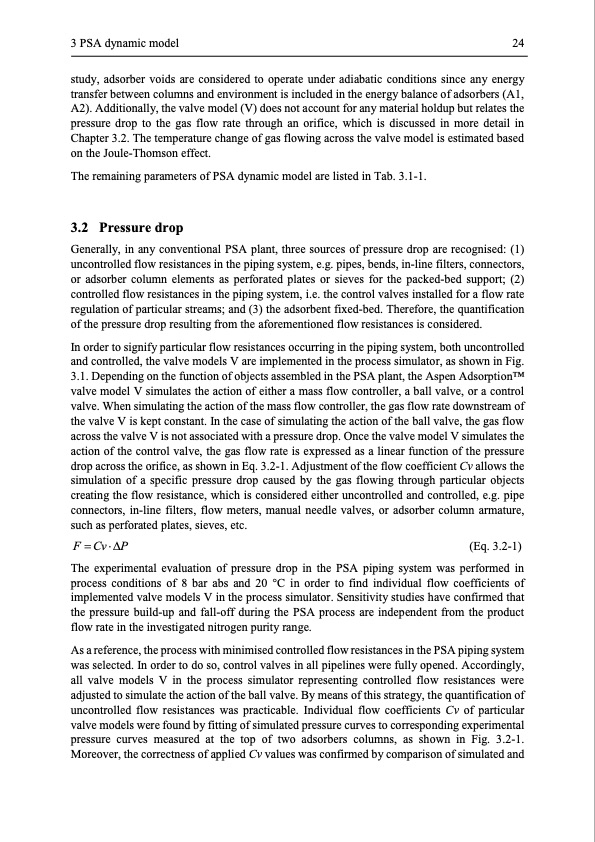
PDF Publication Title:
Text from PDF Page: 037
3 PSA dynamic model 24 study, adsorber voids are considered to operate under adiabatic conditions since any energy transfer between columns and environment is included in the energy balance of adsorbers (A1, A2). Additionally, the valve model (V) does not account for any material holdup but relates the pressure drop to the gas flow rate through an orifice, which is discussed in more detail in Chapter 3.2. The temperature change of gas flowing across the valve model is estimated based on the Joule-Thomson effect. The remaining parameters of PSA dynamic model are listed in Tab. 3.1-1. 3.2 Pressure drop Generally, in any conventional PSA plant, three sources of pressure drop are recognised: (1) uncontrolled flow resistances in the piping system, e.g. pipes, bends, in-line filters, connectors, or adsorber column elements as perforated plates or sieves for the packed-bed support; (2) controlled flow resistances in the piping system, i.e. the control valves installed for a flow rate regulation of particular streams; and (3) the adsorbent fixed-bed. Therefore, the quantification of the pressure drop resulting from the aforementioned flow resistances is considered. In order to signify particular flow resistances occurring in the piping system, both uncontrolled and controlled, the valve models V are implemented in the process simulator, as shown in Fig. 3.1. Depending on the function of objects assembled in the PSA plant, the Aspen AdsorptionTM valve model V simulates the action of either a mass flow controller, a ball valve, or a control valve. When simulating the action of the mass flow controller, the gas flow rate downstream of the valve V is kept constant. In the case of simulating the action of the ball valve, the gas flow across the valve V is not associated with a pressure drop. Once the valve model V simulates the action of the control valve, the gas flow rate is expressed as a linear function of the pressure drop across the orifice, as shown in Eq. 3.2-1. Adjustment of the flow coefficient Cv allows the simulation of a specific pressure drop caused by the gas flowing through particular objects creating the flow resistance, which is considered either uncontrolled and controlled, e.g. pipe connectors, in-line filters, flow meters, manual needle valves, or adsorber column armature, such as perforated plates, sieves, etc. F = Cv P (Eq. 3.2-1) The experimental evaluation of pressure drop in the PSA piping system was performed in process conditions of 8 bar abs and 20 °C in order to find individual flow coefficients of implemented valve models V in the process simulator. Sensitivity studies have confirmed that the pressure build-up and fall-off during the PSA process are independent from the product flow rate in the investigated nitrogen purity range. As a reference, the process with minimised controlled flow resistances in the PSA piping system was selected. In order to do so, control valves in all pipelines were fully opened. Accordingly, all valve models V in the process simulator representing controlled flow resistances were adjusted to simulate the action of the ball valve. By means of this strategy, the quantification of uncontrolled flow resistances was practicable. Individual flow coefficients Cv of particular valve models were found by fitting of simulated pressure curves to corresponding experimental pressure curves measured at the top of two adsorbers columns, as shown in Fig. 3.2-1. Moreover, the correctness of applied Cv values was confirmed by comparison of simulated andPDF Image | Modelling and Simulation of Twin-Bed Pressure Swing Adsorption Plants

PDF Search Title:
Modelling and Simulation of Twin-Bed Pressure Swing Adsorption PlantsOriginal File Name Searched:
dissertation_marcinek.pdfDIY PDF Search: Google It | Yahoo | Bing
CO2 Organic Rankine Cycle Experimenter Platform The supercritical CO2 phase change system is both a heat pump and organic rankine cycle which can be used for those purposes and as a supercritical extractor for advanced subcritical and supercritical extraction technology. Uses include producing nanoparticles, precious metal CO2 extraction, lithium battery recycling, and other applications... More Info
Heat Pumps CO2 ORC Heat Pump System Platform More Info
| CONTACT TEL: 608-238-6001 Email: greg@infinityturbine.com | RSS | AMP |